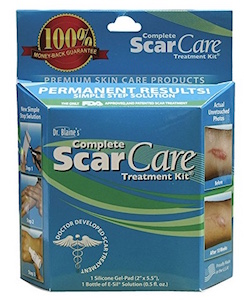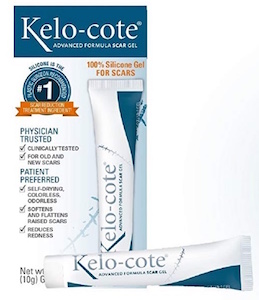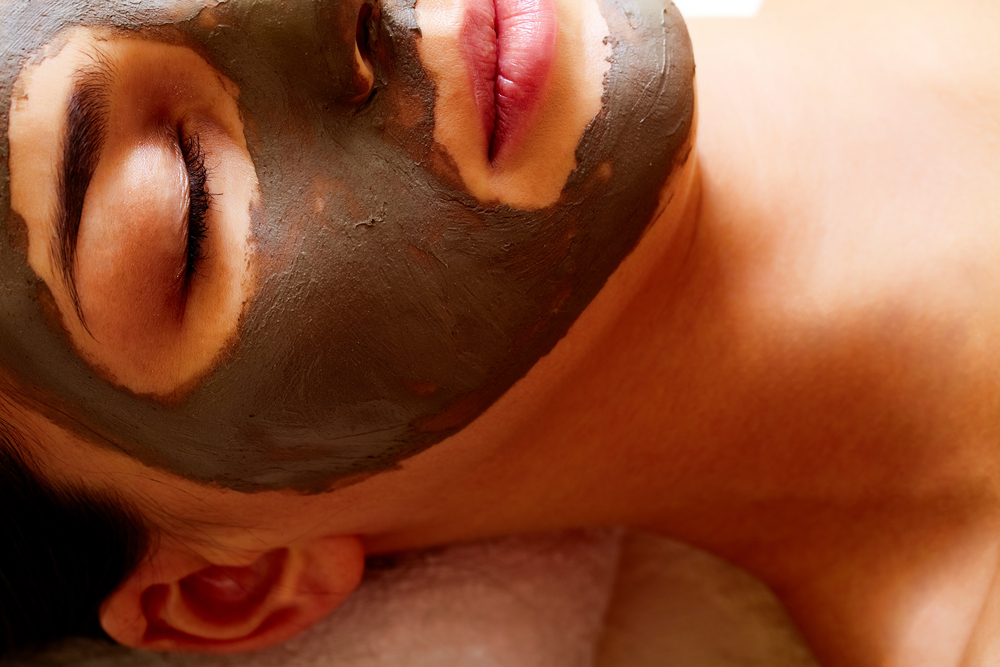- A red, raised scar near the site of a recent injury, may be a hypertrophic scar
- Hypertrophic scars rarely extend more than 4 millimeters above the skin; tend to be hard and sometimes painful
- There are many in office and at home treatments available including cryotherapy, pressure therapy, surgical removal, and more
What are hypertrophic scars?
If you’ve noticed a red, raised scar near the site of a recent injury, you may be developing what’s called a hypertrophic scar. These scars can also pop up at an injury site following burns, pimples, body piercings, cuts, insect bites, and tattoos.
While hypertrophic scars can form anywhere on the body, they’re especially common around the shoulders, upper arms, earlobes, and cheeks.
Hypertrophic scars may result from excessive healing at the site of a surgical incision.
What causes hypertrophic scars?
Hypertrophic scars are the result of abnormal wound healing. Normally when a wound heals, the body is signaled to produce and break down scar tissue, with the balance being tipped in favor of making the scar tissue. Once a wound has healed, scar tissue production normally reaches equilibrium with scar tissue breakdown. With hypertrophic scarring, this equilibrium is not reached, and more scar tissue continues to be produced. This results in thick, excessive hypertrophic scarring.
Hypertrophic scars vs. keloid scars
Hypertrophic scars are actually quite similar to keloids. The main difference between the two is that hypertrophic scars don’t grow beyond the boundary of the injury site, meaning they’re typically smaller than keloids. Hypertrophic scars rarely extend more than 4 millimeters above the skin, and tend to be hard.
Additionally, keloids tend to grow larger over time whereas hypertrophic scars eventually stop growing. Keloids also have a reddish-purple appearance as opposed to the reddish-pink color of hypertrophic scars .
While the treatments are similar for both hypertrophic and keloid scarring, your doctor or plastic surgeon will first identify which type of scar you have before determining the optimal treatment option.
How to get rid of a hypertrophic scar
There are several methods to treat and remove hypertrophic scars, all having been proven effective in numerous studies. The various surgical and non-surgical hypertrophic scar reduction procedures available include:
- Topical silicone gel treatments
- Pressure therapy
- Steroid injections
- Laser treatments
- Radiation therapy
- Cryotherapy
- Surgical excision
Silicone pads
One of the most popular methods for reducing the appearance of hypertrophic scars is topical silicone treatments.
Since the early 1980s, doctors have used topical silicone gel sheeting or silicone pads to reduce the appearance of both keloids and hypertrophic scars.
In general, these sheets contain 100% silicone material and are safe for people of all skin types. They are placed on the scar for a minimum four hours a day over a period of six months to a year.
Studies show that silicone sheets can significantly reduce the appearance of these frustrating scars, with an 80 to 100% improvement rate in scar formation. The silicone gel is believed to deeply hydrate the wound while limiting collagen production, which helps facilitate the regulation of fibroblast — the cells in the connective tissue that produce collagen — to soften and flatten the scar.
In clinical trials, 60% of patients who used silicone scar treatments noted positive improvements.
Pressure garments
Another way to reduce the appearance of hypertrophic scarring is to place a pressure dressing directly at the site of the scar. These garments are not ideal for the face or head, making this type of treatment best-suited to hypertrophic scars on the limbs and body.
Pressure therapy is generally regarded as the “gold standard” when dealing with hypertrophic scars, and has been in use since the 1960’s. However, the exact reason why it works is still not fully understood. Some hypothesize that the pressure controls collagen synthesis and limits the supply of blood, oxygen, and nutrients to the scar tissue.
These garments — often made of latex-free materials to prevent allergic reactions — must be used daily throughout the maturation of the wound in order to prevent the scar from getting worse.
Doctors recommend pressure therapy for up to 23 hours a day for a period of 12 months, using garments that have been specifically fitted to the patient by a skilled technician. For optimal results, pressure garments should be replaced every two to three months.
Steroid injections
Your doctor may recommend monthly intralesional corticosteroid injections to repress hypertrophic and keloid scar formation. In most cases, doctors use fluorouracil or triamcinolone (Kenalog) injections, which help scars flatten and fade while also reducing redness and pain.
Doctors start administering steroids as soon as the original wound begins to show signs of hypertrophic scar formation, and may administer several doses over a given period of time in order to achieve the desired results.
Unfortunately, these injections tend to be painful, so doctors generally only inject small amounts per session. Additionally, these steroids are known to cause several side effects including acne, inflammation, nausea, thinning hair, bruising, weight gain, dizziness, and difficulty sleeping.
That being said, steroid injections reduce scarring very quickly, and have been shown to improve the appearance of scars by 50 to 100%.
Laser treatments
If you’ve ever looked into any other form of laser therapy, you already know that there are dozens of unique types of lasers out there all claiming to provide their own benefits for different applications. When it comes to treating hypertrophic scars however, the gold standard is the pulsed dye laser (PDL).
PDL uses an organic dye solvent as the lasing medium. In the treatment of hypertrophic scars, especially those following thermal burns, specialists typically use the 585 nm PDL.
Several studies have shown that this treatment reduces the hypertrophic scar’s thickness and redness, while also helping to curb any of the scar’s side effects (especially pain and itchiness).
As with most forms of laser therapy, your doctor will likely recommend several treatment sessions. The good news is that almost all PDL therapies come with minimal side effects and require virtually no downtime.
Radiation therapy
While the name “radiation therapy” may cause alarm for some — given that exposure to radiation can trigger the growth of malignant tumors — studies show that the amount of cancer-causing waves present during low-dose radiation therapy are not enough for concern.
Radiation therapy has been proven effective in the treatment of both keloids and hypertrophic scars. This treatment targets scars at the cellular level, zapping the cells that form scar tissue. In other words, these waves deconstruct the fibroblasts that cause excessive collagen synthesis and lead to scarring.
Radiation therapy is a good choice to treat hypertrophic scars because it has the ability to penetrate scars approximately 0.15 inches (4 mm) deep. In some cases, doctors will follow up hypertrophic scar removal surgery with radiation therapy to promote faster wound healing.
Radiation therapy is also a popular choice for patients who don’t want to follow up surgical excision with regular steroid injections, which can be painful.
It is important to note that doctors are unlikely to perform radiation therapy on scars that are on the neck. Radiation therapy close to the thyroid gland — present in the neck — can increase the chances of complications.
Surgical removal
It is possible to have the entirety of the scar tissue surgically removed by a plastic surgeon. One popular method for this is Z-plasty, a surgical scar removal technique that can elongate or rotate a concentrated scar into a position of less tension, improving the appearance and reducing the risk of recurrence. Following this surgery, the amount of collagen that creates the appearance of the scar is decreased, making it appear less prominent.
W-plasty is another surgical method to conceal the scar. W-plasty is essentially many small Z-plasties to break up a linear hypertrophic scar. Similar to a Z-plasty, W-plasties decrease the direction of the scar to diminish the tension and improve the appearance.
A scar may be excised and then repositioned into a fold or crease if there is one nearby so that it heals less visibly.
Scar removal surgery is performed under local or general anesthesia, depending on the patient’s needs and the extent of the procedure.
Doctors will often use basic Z-plasty with other plastic surgery methods in the effort to address more complex hypertrophic scars. In the majority of cases, plastic surgeons require the use of post-surgical steroid injections or radiation therapy to prevent scars from recurring.
Surgical excision not usually recommended as the first line of treatment of hypertrophic scars as the non-surgical methods have been proven to be equally as effective and there is no guarantee the hypertrophic scar will not recur and may get worse.
Cryosurgery
Cryosurgery — using the extreme cold produced by liquid nitrogen to effectively freeze off the scar — has been proven effective in the treatment of keloids and hypertrophic scars.
During a cryosurgery session, your doctor will administer liquid nitrogen to the scar site to destroy the tissue. Although the reasons why are not fully understood, it’s been shown that cryosurgery is more effective in treating hypertrophic scars than keloids.
For the best results, patients must undergo three or more cryotherapy sessions to completely treat a scar. While rare, potential adverse effects that may occur following this treatment include bleeding, the formation of blisters, hair loss, and hyperpigmentation at the site of the wound.
How can I prevent hypertrophic scars?
Scarring is an essential part of wound healing, and anything that prevents the progression of scar formation may increase the risk of wound complications. Preventing hypertrophic scars is far better than trying to treat them. To the extent that hypertrophic scars may result from excessive inflammation, they may best be prevented by the following:
- Keep wounds clean and free from infection
- Deep wounds should be evaluated by a plastic surgeon and, when needed, should be meticulously examined and closed edge to edge
- Avoid sun exposure to the wounds
- Utilize known beneficial healing aids, such as scar cream and silicone sheeting, during the healing process
It should be noted that even with the highest attention paid to prevention, the hard truth is that some people are just more prone to getting hypertrophic scars, and there may be nothing that can be done to prevent it.
Recommended Products for Hypertrophic Scar Treatment
If a doctor has examined your scar and determined it’s hypertrophic and suitable for at-home treatment, look no further than these top products.

Dr. Blaine’s Complete ScarCare Treatment
With a money-back guarantee to flatten and fade, Dr. Blaine’s treatment is a safe bet for those who are suffering from hypertrophic scars. It comes in the form of a gel pad which is washable, reusable and may be cut into any shape.

Mederma Advanced Scar Gel
If your scar is somewhere that is usually uncovered, such as your face, you may prefer a transparent gel like Mederma Advanced Scar Gel over a pad or sheet. Sheets and gels are equally effective for scar reduction, as long as you wear them consistently.

Kelo-Cote Advanced Formula Scar Gel
Specifically formulated for hypertrophic scars, Kelo-Cote is one of the best options on the market for flattening and lightening scars. Like most gels, Kelo-Cote needs to be applied twice a day, but it’s light enough to be worn under sunscreen or makeup.

Mepiform Silicone Sheets
One of the only silicone sheets that’s made for hypertrophic scars, Mepiform restricts movement while scars heal, which has been shown to improve results. The sheets should be worn 24 hours a day, but are flexible enough to not interfere with your daily activities.









